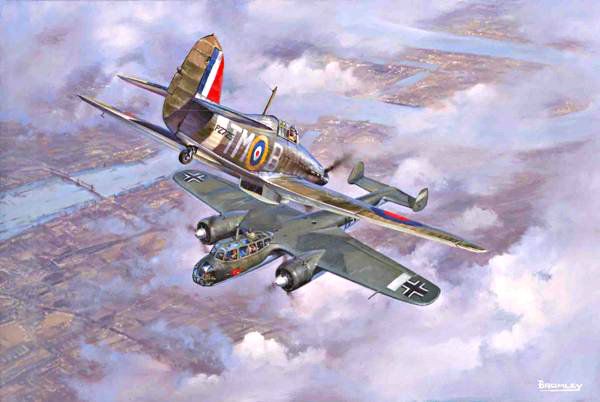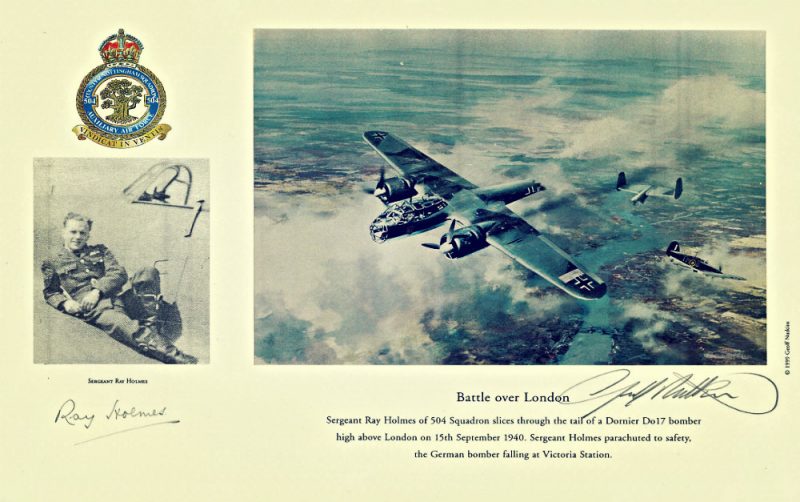Let us recall the story of daring RAF pilot Ray Holmes and how his downing of a German Dornier 17 bomber near Buckingham Palace become one of the most celebrated events during WWII’s Battle of Britain.
Getting to Know the Story
Ray Holmes joined the Royal Air Force Volunteer Reserve [RAFVR] soon after it was established way back in 1936. As a matter of fact, he was the fifty-fifth man to get in the said unit. He became known among his flight comrades as “Arty” which was taken from the initials of his name R.T. which stood for Raymond Towers Holmes.
By the time of the Battle of Britain, the air campaign waged by the Germans against UK during the Second World War, Ray Holmes was already a highly trained and experienced pilot and held the rank of a sergeant. He flew with the 504 Squadron that fateful day – September 15, 1940 – and took off from RAF Hendon in North London with the intent of intercepting the German’s midday raid on the city. That day was also considered the “climax of the Battle of Britain”.
The German Dornier 17 bomber Ray Holmes downed took off from France and right after joining a formation at the height of 15,000 feet, it headed straight towards central London. It managed to avoid RAF fighters as it crossed Dungeness but then, one of its engine started malfunctioning causing it to drop away from the main force. It was at this time that the said German war plane encountered and was attacked by fighters near Battersea just as it was nearing its target. Set on fire by the Hurricanes of 310 (Czech) Squadron, two of the German plane’s crew baled out.
It was this time that Sergeant Ray Holmes entered the scene to deliver further attack on the German Dornier 17 bomber. The onslaught he brought caused the enemy’s aircraft to break up forcing its pilot to bale out. A big piece of the Dornier fell in the Victoria Station’s forecourt. This said scene was depicted – with a great amount of artistic license, of course – in the war classic, Battle of Britain. For more than four decades, the said station’s stone facade bore the scars of the fall.
Ray Holmes, when asked about the event, described it as such:

The Aftermath
The downing of the German bomber by Ray Holmes became one of the most celebrated events in the Battle of Britain not just because in the eyes of many, it was a heroic act from a RAF pilot but also because the fall of the plane happened in a very public place without any English casualties. Additionally, the said occurrence was also captured on film.
However, the fighter plane Ray Holmes was piloting also went down that day forcing him to bale out over Chelsea. He landed on Hugh Street, had risen to celebrity status in a short span of time, was told by onlookers that his enemy crashed at Victoria, got led to the Orange Brewery some hundred yards down Pimlico Road and drank brandy before he was dispatched to Chelsea Barracks. He then paid a visit to an Army doctor and went to the mess for additional drinks before a taxi transported him back to RAF Hendon where he took off earlier that day.
After the event, Ray Holmes went on to fly throughout the Second World War and later on, went on to become a flight instructor for the Russians teaching them how to fly the Hurricane. He also did photo-reconnaissance at high altitudes – from 30,000 feet above Germany – aboard a specially prepared Spitfire.
It was in 1989 when ray Holmes decided to share his exciting and very interesting aviation experiences to the whole world through his autobiography, SKY SPY.
The Discovery
It was sixty-four years later when the plane Ray Holmes flew during that fateful day in the Battle of Britain was excavated. One particular piece of the Hurricane that stood out among the wreckage was the control column or the “joy stick” which appropriately was set to FIRE.
It was in 2004 when the remains of the Hurricane Ray Holmes piloted during the Battle of Britain was excavated. That was 64 years from the time he flew it. The aged former RAF pilot and WWII veteran even had the chance of being reunited with that joy stick after more than six decades.
Ray Holmes stuck with journalism after the war. It was a thing of interest for him even before WWII broke out. He retired at 80 and passed away in 2005, just a year after the discovery of the wreckage of the plane he used to down that German Dornier 17 way back in World War Two.
Artwork
The amazing artwork used in this post can be bought online from Aviation Art by Geoff Nutkins:
